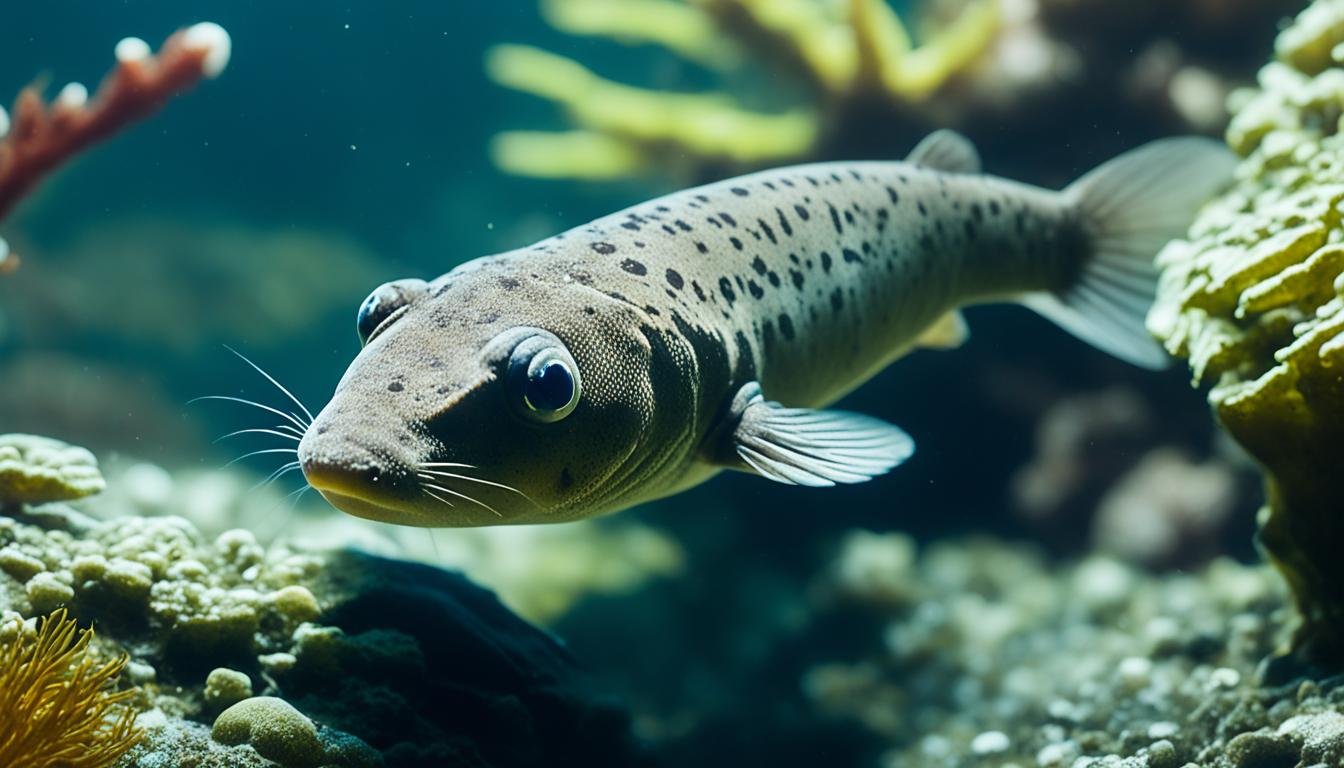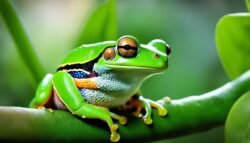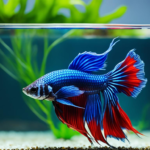The common mudpuppy (Necturus maculosus) is a unique amphibian found in North America. It’s the largest fully aquatic salamander in Michigan. Scientists and nature lovers find these creatures fascinating.
They stand out because of their feathery red external gills. These gills help them breathe underwater throughout their lives.
Mudpuppies are unlike any other amphibian. They have flat heads, wide tails, and short legs with four toes each. These features help them live in the water well.
Their gray or brownish-gray skin is covered with blue-black spots. This makes them blend in with their surroundings in the water.
Introduction to the Common Mudpuppy
The common mudpuppy, known as Necturus maculosus, is an interesting aquatic salamander. It belongs to the Caudata group. These amphibians are known for their unique look and how well they live in water. They are also called waterdogs and can make sounds, similar to a dog’s bark.
Mudpuppies have a body that’s not as specialized as other amphibians. This lets them live in different types of water. They have lungs but mostly breathe through feathery red gills outside their body. This helps them stay underwater for a long time without needing air.
The common mudpuppy is part of the Necturus genus, which has six species. It’s very similar to the Red River mudpuppy (Necturus louisianensis). Both are seen as subspecies of Necturus maculosus. You can find them in the U.S. and Canada, in places like Alabama, Arkansas, Georgia, Illinois, Manitoba, Ontario, and Quebec.
| Characteristic | Description |
|---|---|
| Adult Length | 20-49 cm |
| Hatchling Size | 14-15 mm snout to vent length (21-25 mm total length) |
| Juvenile Resemblance to Adults | Starts at 13-15 cm total length |
| Subspecies | Necturus maculosus (common mudpuppy) and Necturus louisianensis (Red River mudpuppy) |
Mudpuppies are important for checking how healthy the water is. Their presence shows the health of the water. But, they face threats like pollution, siltation, and damage to their homes. This has caused their numbers to go down in some places.
Physical Characteristics of Mudpuppies

The Common Mudpuppy is a unique aquatic salamander with distinct physical traits. These traits help it live in its aquatic home and catch the eye of nature lovers and scientists.
Size and Appearance
Mudpuppies are among the biggest salamanders in North America. Adults can be 20 to 40 cm (8-16 inches) long. The average length is about 30 cm (12 inches), but some can reach up to 50 cm (20 inches).
They have strong, long bodies with a flat head and a wide tail that helps them swim. Their skin is smooth and can be grayish-brown or rusty-brown. They have blue-black spots all over, which helps them hide in the water. The bottom side is usually lighter, from pale gray to yellowish.
Unique Features: External Gills
Mudpuppies stand out with their bushy, red external gills. Unlike many other salamanders, they keep these gills their whole life. These gills are on the sides of their head and help them breathe underwater, making them look quite unique.
They also have big eyes and four toes on each foot. These toes are short but great for holding onto rocks and other things under water.
| Physical Characteristic | Description |
|---|---|
| Size | 20-40 cm (8-16 inches) on average, up to 50 cm (20 inches) |
| Body Shape | Robust, elongated, with a flattened head and wide tail |
| Coloration | Grayish-brown or rusty-brown with blue-black spots |
| External Gills | Bushy, red, feathery gills on either side of the head |
| Toes | Four toes on each foot, stubby and not webbed |
Habitat and Distribution
The Common Mudpuppy lives in freshwater places in the United States and Canada. These salamanders love the water and never come onto land. They live in lakes, ponds, rivers, and streams, hiding under rocks, logs, and plants.
Aquatic Environments: Lakes, Ponds, Rivers, and Streams
Mudpuppies like many types of water, from calm lakes to fast rivers. They prefer places with lots of rocks and logs. These spots help them hide and find food.
In rivers and streams, they like slow-moving water with lots of underwater hiding spots. These spots protect them from predators and are full of food.
Geographic Range
The Common Mudpuppy lives from southern Canada to the eastern United States. They are found in many places, including the Great Lakes and the Mississippi River. They also live in parts of North Carolina, Georgia, and Mississippi.
In the United States, you can find them in states like New York and Vermont. In Canada, they live in Quebec and Manitoba. But they are not found in places like Alaska or Hawaii.
| Region | Distribution |
|---|---|
| United States | Midwestern states, east to North Carolina, south to Georgia and Mississippi |
| Canada | Southern central Canada, including Quebec and Manitoba |
| Major River Systems | Tributaries of the Great Lakes, Mississippi River, and Hudson River |
| Other Notable Habitats | Lake Champlain |
Mudpuppies live in many places, but they are not everywhere. For example, in Connecticut, they are found in certain rivers and streams. They are not as common as some other animals.
Behavior and Lifestyle

The common mudpuppy is a unique aquatic salamander with interesting behaviors. They are most active at night, coming out to hunt for food and explore. These creatures are great at moving through dark waters, using their senses to find food and stay safe.
Nocturnal Habits
Mudpuppies are mostly active at night. By day, they hide under rocks, logs, and in thick plants to stay safe and cool. When night falls, they come out to hunt and move around. This helps them hunt better and avoid dangers in the dark.
Feeding Habits and Diet
Mudpuppies eat a wide variety of things, like crayfish, worms, snails, and small fish. They use their strong sense of smell and touch to find food in the dark. Once they find something to eat, they grab it quickly with their strong jaws and teeth.
They eat a lot, making up a big part of their body weight in food daily. This helps keep the balance in aquatic ecosystems. They also eat invasive species like round gobies, which helps control their numbers.
| Prey Type | Percentage of Diet |
|---|---|
| Crayfish | 35% |
| Worms | 25% |
| Snails | 20% |
| Small Fish (e.g., Round Gobies) | 20% |
Mudpuppies have unique habits and eat a wide variety of things. This shows how adaptable and important they are in aquatic ecosystems. By understanding their behavior and what they eat, we can see how they help keep their habitats balanced.
Reproduction and Life Cycle
The life cycle of mudpuppies is quite interesting. These salamanders have a special way of mating and a long process from egg to adult. Knowing how they reproduce and grow helps us understand their role in nature and why we should protect them.
Mating and Egg-laying
In late fall, mudpuppies mate, but the females wait until spring to lay eggs. During mating, males and females perform a special dance. The male leaves a spermatophore for the female to pick up. After fertilization, the female finds a safe place to lay about 60 eggs, sometimes up to 200.
She attaches the eggs to a rock or log under the water. The female guards the eggs until they hatch after 40 to 50 days.
Larval Development
After 40 to 50 days, the eggs hatch, and tiny larvae come out. These larvae are small and have a yolk sac for food. They grow and lose the yolk sac, reaching about 3.6 cm long.
After a month, they start to grow legs and change into adults. This change can take up to two years, during which they lose their stripes and grow to about 20 to 33 cm long.
Lifespan and Sexual Maturity
Mudpuppies can live over 20 years in the wild, but most live about 11 years. They grow slowly, taking 4 to 6 years for females and up to 5 years for males to be ready to have babies. Once adults, they can have babies every year, helping their populations stay healthy in good habitats.
| Life Stage | Duration | Key Developments |
|---|---|---|
| Egg | 40-50 days | Embryonic development |
| Larva | 1-2 years | Growth, leg development, loss of juvenile stripes |
| Adult | 11-20+ years | Sexual maturity, annual reproduction |
Ecological Role and Importance
The Common Mudpuppy is key to aquatic ecosystems. It acts as a bio-indicator of water quality and interacts with many species. Being a long-lived amphibian, it’s sensitive to environmental changes. This makes it crucial for monitoring the health of lakes, rivers, and streams.
Bio-indicators of Water Quality
Mudpuppies are very sensitive to pollutants and changes in water quality. They are great bio-indicators of environmental health. If they’re present, the water is likely clean and well-oxygenated.
But, if their numbers go down, it could mean the water quality is getting worse or there are contaminants. By watching mudpuppy populations, scientists can check the health of aquatic habitats. They can then take steps to protect these ecosystems.
Interactions with Other Species
Mudpuppies eat a lot of different things, like crayfish, insect larvae, and small fish. They help keep the populations of these organisms in check. This keeps the aquatic food web balanced.
They also eat invasive species like the round goby. This can help control their numbers and lessen their impact on native species. Some people think mudpuppies harm native fish by eating their eggs, but there’s no proof of this. In fact, they might actually help native fish by controlling invasive species.
| Ecological Role | Significance |
|---|---|
| Bio-indicator | Sensitive to water quality changes, indicating ecosystem health |
| Prey | Serves as a food source for various predators, such as large fish and birds |
| Predator | Regulates populations of aquatic organisms, including invasive species |
| Nutrient cycling | Contributes to the transfer of energy and nutrients within the ecosystem |
The Common Mudpuppy does more than just act as a bio-indicator and predator. It’s an important part of the aquatic ecosystem. It helps with nutrient cycling and is food for larger animals like fish and birds. Healthy mudpuppy populations show that the aquatic environment is balanced and resilient.
Conservation Status and Threats
Mudpuppies are not in big trouble globally, but they face threats that can hurt local numbers. The International Union for Conservation of Nature (IUCN) says they are Least Concern. But in places like Iowa, the common mudpuppy (Necturus maculosus) is seen as threatened and a Species of Greatest Conservation Need.
Habitat loss is a big problem for mudpuppies. They need clean water and the right habitat at every stage of their life. Things like dredging, damming, and pollution can destroy their homes, making fewer of them. Also, dirty water can hurt their health and survival.
Lampricides are another big threat. These chemicals are used to fight invasive sea lampreys in the Great Lakes. But, they can also hurt mudpuppies. Studies show that these chemicals can cause birth defects and death in mudpuppies.
Too many mudpuppies being taken for bait or for science can also hurt their numbers. Some anglers think they are poisonous or venomous and end up killing them by mistake. It’s important to teach people the right way to handle and release mudpuppies.
| Region | Conservation Status |
|---|---|
| Global (IUCN) | Least Concern |
| Canada | Not at Risk (assessed in 2000) |
| Iowa | Threatened, Species of Greatest Conservation Need |
| Minnesota | Species of Special Concern |
Even with threats, mudpuppies are pretty resilient. They’re not in big trouble overall, but some places might be harder for them. We need to protect their homes, make the water cleaner, and use lampricides wisely to help them survive.
Myths and Misconceptions about Mudpuppies

Mudpuppies are often misunderstood, leading to confusion and fear. It’s important to clear up these myths for the right conservation and management of these creatures.
Clearing Up Common Misunderstandings
Many think mudpuppies are fish with legs, but they’re not. They are fully aquatic salamanders in the amphibian family. Another myth is that they can survive being frozen and come back to life in spring. But, they don’t freeze and come back to life.
Some believe mudpuppies eat a lot of fish eggs, which isn’t true. They mostly eat crayfish and small baitfish, especially in the ice season. They also aren’t poisonous, despite looking scary.
Importance of Accurate Information
It’s key to correct myths about mudpuppies for several reasons. First, it stops people from treating them badly because of false beliefs. When people know the truth about mudpuppies, they’re more likely to protect them.
Right info helps with mudpuppy conservation too. We can use them to check on water quality. Knowing about their needs and life cycle helps us protect them better.
| Myth | Fact |
|---|---|
| Mudpuppies are legged fish | Mudpuppies are fully aquatic salamanders |
| Mudpuppies can survive being frozen | Mudpuppies do not enter a coma-like state when frozen and will not survive |
| Mudpuppies significantly impact sport fish populations | Mudpuppies primarily feed on crayfish and small baitfish |
| Mudpuppies are poisonous | Mudpuppies are not poisonous despite their appearance |
By sharing accurate info and debunking myths, we can help people appreciate mudpuppies more. This leads to better conservation and understanding of these amazing creatures.
Human Interactions with Mudpuppies
Mudpuppies often meet humans through fishing. Anglers might catch them by mistake while fishing for other fish. This leads to humans and mudpuppies interacting unintentionally.
Accidental Catches by Anglers
Anglers fishing in places where mudpuppies live might catch these salamanders. They’re not usually what anglers want to catch. But, it’s important for anglers to handle these situations right. This keeps the animal safe and follows the law.
Proper Handling and Release Techniques
When an angler catches a mudpuppy by mistake, it’s key to handle and release it right. These salamanders are slimy but safe for humans. Anglers should take the hook out of the mudpuppy’s mouth carefully to avoid hurting it.
To safely release a mudpuppy, do this:
- Wet your hands before touching the mudpuppy to protect its skin.
- Hold the mudpuppy with both hands, making sure to support its body without too much pressure.
- Use pliers or a hook remover to carefully take out the hook.
- If the hook is stuck too deep or hard to remove, cut the line close to the hook to avoid more harm.
- After removing the hook or cutting the line, put the mudpuppy back in the water. Make sure it’s fully wet before you let it go.
In places like Michigan, mudpuppies are protected by law. In 2016, they were made a species of concern by the Michigan Department of Natural Resources. This means it’s illegal to take or keep them without the right permits. Anglers should know the local rules about mudpuppies and other water creatures. This helps with responsible fishing and helps protect nature.
By being careful with mudpuppies and releasing them right, anglers can lessen their effect on these interesting creatures. This helps keep the species safe for future generations to enjoy and learn about.
Research and Conservation Efforts
Many groups are working hard to save the unique mudpuppy. The Wisconsin Department of Natural Resources (DNR) is leading this effort. They aim to learn more about the mudpuppy and may start conservation plans soon.
The Wisconsin Amphibian and Reptile Conservation Fund was set up in 2017. It helps with the conservation, education, research, and monitoring of Wisconsin’s native amphibians and reptiles. In 2022, the Wisconsin DNR got a $5,000 grant from this Fund for mudpuppy research and conservation. This money will help us learn more about where these creatures live and how many there are. Sadly, about half of Wisconsin’s amphibians and reptiles are at risk.
Ongoing Studies and Initiatives
The mudpuppy research project aims to understand where they live now and where they used to live. It also wants to find the best ways to keep track of them over time. This information will help conservationists make smart plans to protect these unique amphibians.
Other states where mudpuppies live are also taking action. In Minnesota, they are considered a species of special concern. In Iowa and Illinois, they are threatened, showing that their numbers might be going down. These actions highlight the need for more research and conservation to save mudpuppies.
Public Involvement and Citizen Science
Getting people involved is key to saving mudpuppies. Citizen science lets people help by sharing their findings and observations. For example, if anglers catch mudpuppies while ice fishing, they should put them back and tell the local wildlife authorities.
It’s also important to teach people why mudpuppies matter in our ecosystems. By learning about these salamanders, we can get more people to support their conservation. This will help protect these often-overlooked creatures.
| State | Conservation Status | Research and Conservation Efforts |
|---|---|---|
| Wisconsin | Species of Concern | DNR research project, NRF Conservation Fund |
| Minnesota | Species of Special Concern | Ongoing monitoring and habitat protection |
| Iowa | Threatened | Population surveys and conservation planning |
| Illinois | Threatened | Habitat restoration and public outreach |
Supporting groups that protect mudpuppies and other endangered species is vital. With ongoing research, protecting their homes, and getting people involved, we can help these amazing salamanders thrive.
Conclusion
The common mudpuppy (Necturus maculosus) is a fascinating creature that grabs the interest of scientists and nature lovers. It has special features like permanent gills and a flat head. These traits help it live in the clear waters and rocky places of North American lakes, rivers, and streams. It’s important for keeping the water healthy and balanced, acting as a key indicator of water quality.
Even though they were once common in the Great Lakes area, mudpuppies are now fewer in number. Human actions like destroying their homes, polluting, and bringing in non-native species threaten their survival. We need to work together to protect mudpuppies and their homes, so they can keep living in our waters for a long time.
Sharing the truth about mudpuppies helps us appreciate them more. Research and conservation efforts, along with projects where the public can help, are key to understanding these salamanders. By working together, we can find ways to save this amazing species and keep our water ecosystems healthy and diverse.
FAQ
What is a common mudpuppy?
The common mudpuppy (Necturus maculosus) is a big, water-dwelling salamander from North America. It’s known for its special gills that it keeps all its life.
What do mudpuppies look like?
Mudpuppies have flat heads, wide tails, short legs, and feet with four toes. They are gray or brownish-gray with blue-black spots. They have big, red gills and can grow up to 16 inches long, but usually they are about 11 inches.
Where do mudpuppies live?
Mudpuppies live in the bottoms of lakes, ponds, rivers, and streams in southern central Canada, the midwestern United States, and parts of the eastern United States. They live under rocks, logs, and plants and never leave the water.
What do mudpuppies eat?
Mudpuppies are night-time eaters and eat whatever they can find. They eat crayfish, worms, snails, and small fish, like round gobies.
How do mudpuppies reproduce?
Mudpuppies mate in late fall and the females lay 50-100 eggs in the spring under rocks. They protect the eggs until they hatch, which is 1-2 months later.
Are mudpuppies important for the environment?
Yes, mudpuppies are important because they are sensitive to pollution and changes in water quality. They help keep invasive species in check with their eating habits.
Are mudpuppies endangered?
Mudpuppies are not endangered overall, but some local groups face threats from losing their homes, poor water quality, and being caught or harmed by people.
What should I do if I accidentally catch a mudpuppy while fishing?
If you catch a mudpuppy by accident while fishing, be gentle and put it back in the water. Remove any hooks before letting it go. In some places, like Michigan, it’s illegal to keep mudpuppies without the right permits.
How can I contribute to mudpuppy conservation efforts?
You can help mudpuppies by sharing where you see amphibians and reptiles with local groups or using apps for this. Supporting groups that study and protect mudpuppies is also a good way to help.















